
Let’s talk healthy kitchen updates, shall we? Updating your kitchen is also one of the more expensive projects in your home (that and bathrooms, am I right?). Our kitchen is completely functional, but aesthetically, definitely not where I would dream it to be. But in all honesty; that’s okay with me. I know that it means I have lots of time to make my choices in changes and really plan out how I want my kitchen to look.
If you’ve been around for a minute, you know that I love a good planning worksheet when it comes to home projects (or any project for that matter!). Planning out anything within your house is beneficial because it allows you the great opportunity to choose your materials and installation method very carefully. When you get to really plan ahead and research the products you want, you’ll make better choices and healthier decisions for your house.
In addition to making a healthier choice for your home. It’s also important to look at the resale of your home with these stylistic changes. Making a home unique is one thing, but making a home unique AND appealing to others is the golden ticket. Eventually we will all move on from our homes and we’ll need to sell them. If you’ve made a stylistic change that really isn’t the “norm”, you might be writing your fate when it comes time to sell. Carefully choosing finishes and materials for the kitchen is a great place to add value to your home, if you’re doing the research and planning it out.
And the great thing with kitchens, is that if you do like the layout and you’re just not digging the style, you can do a simple “face lift” if you will. This means you don’t necessarily have to rip out every cabinet, or replace all the appliances for that matter. It means you can update portions of your kitchen without even worrying about appliances, plumbing or a complete remodel.
Doing more of a face lift option also means you won’t be creating as much waste compared to a full remodel where you may need a dumpster for materials that are being disposed of. And while there are many things you can update in your kitchen, today I’m focusing on a few of the big ones and giving you some ideas healthier materials and installation methods in your own kitchen.
I also have a healthy remodel checklist and planner that can help walk you through each of the areas of your kitchen so you don’t miss anything.
Creating a Healthy Kitchen: A Guide to Toxin-Free Updates
The kitchen is the heart of the home, but it can also be a source of hidden toxins. Whether you’re planning a full remodel or just making small updates, choosing non-toxic materials and mindful design choices can help you create a truly healthy kitchen. In this guide, we’ll explore toxin-free materials, sustainable updates, and ways to maintain a safe and inviting space without compromising on style or functionality.
Planning a Healthy Kitchen Remodel
A kitchen update doesn’t have to mean a full gut job. In fact, making small, intentional changes can have a big impact on both your home’s air quality and your family’s well-being. Before you start, take time to research materials, finishes, and installation methods to ensure they align with your goal of a healthier space. This will also help you balance aesthetics, functionality, and resale value.
A great first step is to identify areas where toxins may be lurking. Many conventional kitchen materials—like laminate countertops, standard cabinetry, and certain flooring types—can off-gas harmful chemicals like formaldehyde and VOCs (volatile organic compounds). By choosing healthier alternatives, you can significantly improve indoor air quality and reduce long-term exposure to harmful substances.
Toxin-Free Countertops for a Healthy Kitchen
Counter tops are a great way to update your kitchen or give it a whole new look. A lot of times this includes getting rid of the old laminate counter tops and installing something more timeless. In my opinion, a laminate counter top is not necessarily the healthiest option for a home in the first place. It usually has a particle board beneath the laminate top. And if we’ve learned anything about particle board, it’s that it off-gasses formaldehyde and other VOCs for the lifetime of the product. It also tends to off-gas more when it’s in a warm, humid environment — like your kitchen.
The good news is that not only are there really affordable options when it comes to replacing your counter tops, but there are also really beautiful options too.
Wood: Wood is a natural element and can be beautiful as a counter top. You’ll want to make sure the wood is sealed with a low or no VOC finish to protect the wood from damage and water. Wood is actually naturally protects against bacteria, which is why it’s a great surface for kitchens. It’s also really easy to fix if it does become damaged as you can just sand the counter and reseal it. There’s definitely a level of maintenance for these counter tops, so make sure you’re up for it before you decide.
Concrete: Concrete is a great option as it can be almost completely customizable. From shape to color you can pretty much choose what you want. Concrete counter tops will need to be sealed in order to be stain resistant. It’s also naturally resistant to very high heat, however the heat can damage or discolor the sealer on it. Check with your contractor to find a concrete that does not contain vinyl or latex if you want to keep it 100% healthy.
Quartz: While it is a man-made product, Cambria Quartz is actually one of the few counter tops with the GreenGuard stamp of approval. These counter tops are extremely resistant to moisture, heat and scratches. And the best part is that they rarely require any sort of sealing. It’s fairly easy to find this material, but it is priced on the higher end.
Natural Stones: Marble, limestone and quartzite (Not to be confused with man-made quartz) are natural stones found in the earth. All of these are great options because they’re natural. They come directly from the earth and undergo very little processing. These stones must be sealed, however, and you’ll have to be willing to work with that maintenance. You’ll also want to make sure find a sealer that is chemical free and natural if possible.
Stainless Steel: Stainless steel is an incredibly durable surface. They don’t chip and typically there is virtually no staining with stainless steel. Stainless steel is also naturally resistant to bacteria, which makes it perfect for the kitchen. It’s definitely a style preference, and depending on the style of your home, may not be great for resale.
IceStone: IceStone is a newer product that is an excellent eco-friendly option. IceStone is made of 100% recycled glass mixed with non toxic portland cement. It’s also free of all plastics and petrochemicals. Their countertops are naturally scratch resistant, but does require a bit of maintenance in terms of sealing the product from time to time.
You might notice I didn’t list granite in this list. And it’s all for good reason. While granite is a stone and a natural element of the earth, it unfortunately adds radon to the air of homes naturally. Homes that already have a high concentration of radon may want to steer clear of this product. The other downside to granite is that it is often chemically sealed rather than polished, which brings chemicals into your home and onto your eating surface.
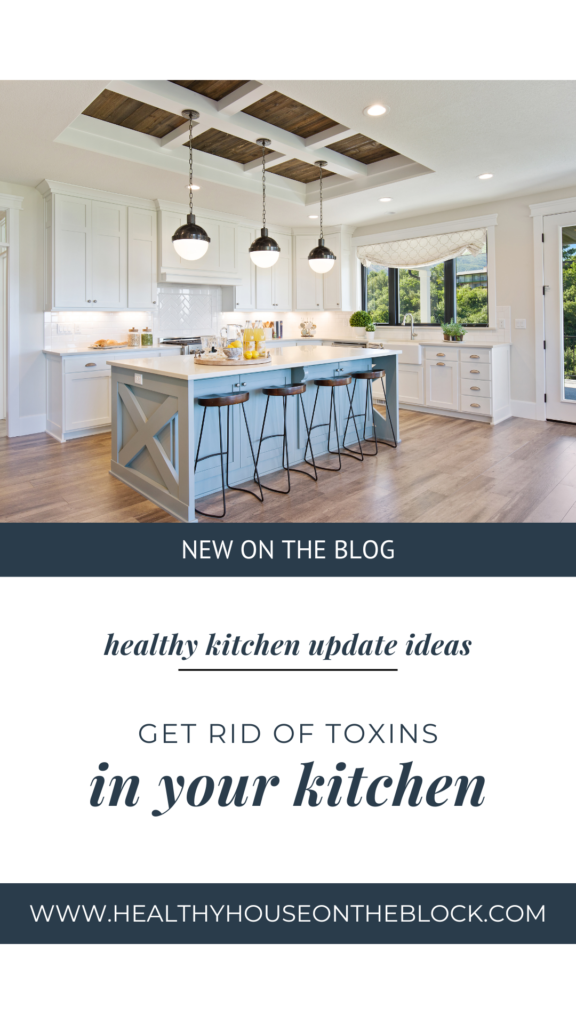
Healthy Kitchen Cabinet Updates
Ripping out all of your cabinets and installing all new might not be in your budget, or you might realize how much waste that can create. Either way, if you’re just looking to update your cabinets rather than change the layout or the design, there are so many ways you can update them without doing a messy and expensive renovation in your kitchen.
Paint: This is probably the most common choice to give your kitchen a really big update on a small budget. There is definitely a lot of work involved in painting your cabinets the right way, but in the end it’s so worth it. Most homes do a variation of white cabinets, but greys and blues have also been starting to pop up too.
This option is a great way to not only update your look, but also a great chance to use non-toxic paints and sealers on your materials. AFM SafeCoat is one of my favorite options when it comes to a safe, non-toxic paint and primer. ECOS is another great brand that can get you a non-toxic paint and primer in a variety of colors.
Refacing: Sometimes you want to update your kitchen, but you’re not into that painted look. I get it! I work with lots of people who have strong opinions on painted wood and prefer a more natural appearance to their cabinets. I’m a bit on the fence, to be honest. I love the brightness of a white kitchen, but the thought of wiping down those cabinets day in and day out to keep them clean is a bit daunting.
Refacing is where you remove the current drawers and doors from your current cabinets. Hardware and hinges should be removed too. Once you have just the open cabinets, you’ll need to add new wood to them in order to be able to stain and seal the wood to the color you want.
You’ll then get new doors and drawers with the style you prefer, which will be stained and sealed the same color.
Opt for a non toxic wood stain and wood sealer. AFM SafeCoat also makes wood stains and sealers, which are completely safe and non toxic.
Sealing Particle Board: If your cabinets are particle board on the inside, this is a great time to use AFM SafeSeal to go over these surfaces. Particle board off-gasses formaldehyde for the lifetime of the product and by sealing it, you can reduce the amount that is off-gassed into your own home.
Sustainable New Cabinets: If you’re investing in new cabinetry, look for solid wood options with non-toxic finishes, FSC-certified materials, or brands that specialize in formaldehyde-free construction. Be sure to check out this in depth post about choosing new cabinets.

Non-Toxic Backsplash
Adding a backslash can change the whole look of your kitchen. And the best part is that it usually doesn’t have to entail a professional and you can do it yourself. There are so many options when it comes to creating a gorgeous backslash. Tile in general is completely non-toxic and safe for any home. You’ll just want to make sure that you’re using a chemical free grout.
Cement Based Grout: The grout that is used can also be a toxin free choice you make to avoid any VOCs from entering your space during curing and during installation. You’ll want to look for something that is concrete based as that is generally non toxic in nature. You can also look for products that are either a thin-set or quick cure formula to ensure any VOC exposure is minimal. I recommend Laticrete Thin Set Mortar
Low VOC Grout & Tile Sealer: While tile usually isn’t a porous surface, grout certainly is. And this means that it can absorb moisture and become a spot for mold or mildew to begin in your home. It can also become stained or begin to wear away due to it being unsealed. You can seal grout with a safe, non toxic product like Safecoat Grout Sealer to protect your hard work and make the surface truly washable.
Tile: Look for a tile that has a 100% lead free glaze on it if you’ll be getting any sort of clay or ceramic tile. Most manufacturers adhere to this standard, but every now and then you’ll find one that doesn’t, so doing your research before you buy is best.
Stone Veneer: Stone veneer can be another great option as you don’t have to use any sort of grout when installing. However, you’ll want to make sure that you’re using the appropriate adhesive and that the adhesive is non-toxic. AFM SafeCoat has a 3 in 1 adhesive that is a great product for this type of application. But again, you’ll want to check with the manufacturer.
Recycled Glass: Using a material such as recycled glass for your backsplash is a great way to incorporate not only some character into your home, but to make a conscious effort to use a recycled material. MineralTiles has sets of recycled glass tiles, but you could probably find someone locally who sold recycled glass as well.
Want to dive deeper into tile and grout options? Head to this blog post all about toxin free tile.

Flooring Options for a Healthy Kitchen
The most important thing to remember about your kitchen is that there are many sources of water inside your space.
Any flooring you choose needs to be appropriate for a potentially wet area.
- Solid Hardwood: Choose sustainably harvested wood with a non-toxic, low-VOC finish.
- Cork: Naturally antimicrobial and comfortable underfoot, cork flooring is a great non-toxic option for kitchens.
- Linoleum: Made from natural materials like linseed oil, cork dust, and wood flour, linoleum is a durable, toxin-free alternative to vinyl flooring.
- Tile: A classic and long-lasting choice, tile is naturally non-toxic, especially when paired with toxin-free grout and sealers.
My flooring post is a great way to get started as it talks all about the various flooring materials you can use in your home. Ideally for a kitchen you want a flooring that is very resistant to water and moisture.
Healthy Appliances and Fixtures for a Healthy Kitchen
When it comes to appliances, we are trying to avoid very specific toxins like lead, polyvinyl chloride and perfluorochemicals.
You can try to find appliances that are RoHS certified, however these can be difficult to find. Another option is to find appliances that are manufactured in European countries that adhere to the EU regulations.
These two posts will help you shop for healthier appliances in the kitchen:
And then there’s your fixtures. The BIGGEST consideration is finding a truly lead free faucet with a 100% lead free waterway. This post has several brands that you can shop for when it comes time to replace your faucet.
Don’t forget your sink either. There are some really healthy options you can go for in your kitchen.
Fireclay Sinks: Fireclay sinks are made from natural materials – primarily clay and porcelain – fired at extremely high temperatures. These sinks are incredibly durable and completely inert, meaning they won’t leach any chemicals into your water. The smooth, non-porous surface also prevents bacteria growth, making them an excellent choice for health-conscious families.
Stainless Steel: When choosing stainless steel, look for medical-grade 316 stainless steel (also called surgical steel). While 304-grade is common, 316 offers superior corrosion resistance and better for corrosion protection from cleaners and minerals. (If you need nickel free, 430 stainless steel is free from that metal, making it ideal for families with metal sensitivities).
Copper Sinks: While copper sinks do require more maintenance, they offer unique health benefits. Copper has natural antimicrobial properties that can actually kill harmful bacteria. When choosing a copper sink, look for one that’s at least 99% pure copper without additional metals or coatings.
Stone Sinks: Natural stone sinks, particularly those made from granite or soapstone, offer another toxin-free option. These materials are completely natural and, when properly sealed with non-toxic sealants, provide a beautiful and safe surface for your kitchen.
Head to this post where I break down EVERYTHING you need to know about choosing a kitchen sink.
Don't Skip the Water Filter
Make sure you’re also addressing your drinking water. Most water contains contaminants like chlorine, fluoride and PFAS.
The Cloud Water Filter is an option to get rid of all these toxins and more. It stands out for several key reasons that align with creating a healthier, low-toxin home:
Low Waste-Water Ratio: Unlike many reverse osmosis (RO) systems that waste large amounts of water, Cloud uses a 1:1 waste ratio thanks to its efficient holding tank—making it a more sustainable choice.
Remineralizing Filter: While RO systems remove toxins like PFAS, heavy metals, and pesticides, they can also strip out beneficial minerals. Cloud solves this by adding calcium, magnesium, potassium, zinc, and more back into your water, creating alkaline, mineral-rich water straight from the tap.
Tested & Certified: Cloud’s filters are third-party tested and certified for NSF 42, 53, 58, and 401 standards—ensuring high-quality filtration you can trust.
Truly Lead-Free Faucet: The included faucet is made of 100% stainless steel and is completely lead-free, so your clean water stays clean all the way to your glass.
DOWNLOAD YOUR HEALTHY KITCHEN REMODEL GUIDE & WORKSHEET
ConvertKit Form

DECOR
Even the small details in your kitchen can contribute to a healthier space. When selecting decor and everyday items, opt for:
- Organic textiles like cotton or linen for dish towels and rugs.
- Glass or stainless steel food storage to avoid plastic leaching.
- Natural materials like bamboo, stone, and ceramic for utensils, bowls, and servingware.
- Low-VOC candles or essential oil diffusers for freshening the air without synthetic fragrances.

- Carafe 2. Ceramic Planter 3. Turkish Towels 4. Glass Canisters 5. Ceramic Diffuser 6. Beaded Glasses
A healthy kitchen isn’t just about aesthetics—it’s about creating a space that supports well-being for you and your family. By choosing non-toxic materials, reducing chemical exposure, and making mindful upgrades, you can transform your kitchen into a safer, more sustainable space.
If you’re planning a kitchen update, my Healthy Kitchen Remodel Guide & Checklist can help you select the best materials, plan your budget, and ensure you’re making the healthiest choices. Download it today and start creating a kitchen that nourishes both your body and your home!
Share this:
- Click to share on Facebook (Opens in new window) Facebook
- Click to share on LinkedIn (Opens in new window) LinkedIn
- Click to share on Reddit (Opens in new window) Reddit
- Click to share on Pinterest (Opens in new window) Pinterest
- Click to print (Opens in new window) Print
- Click to share on X (Opens in new window) X

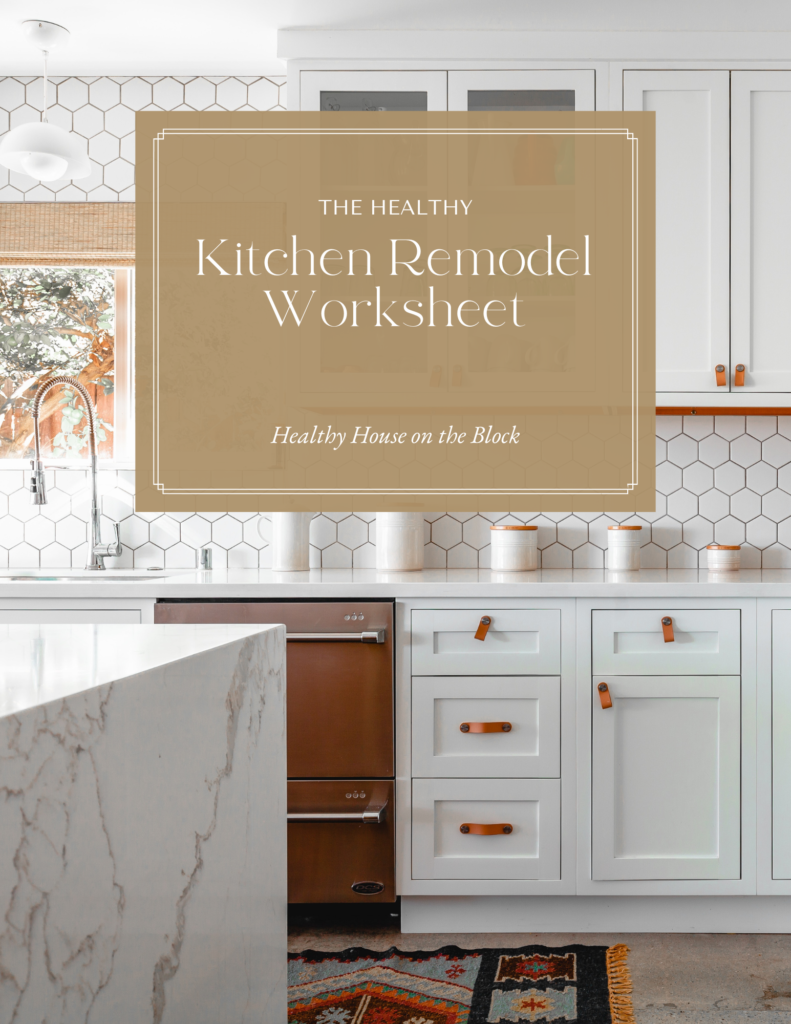
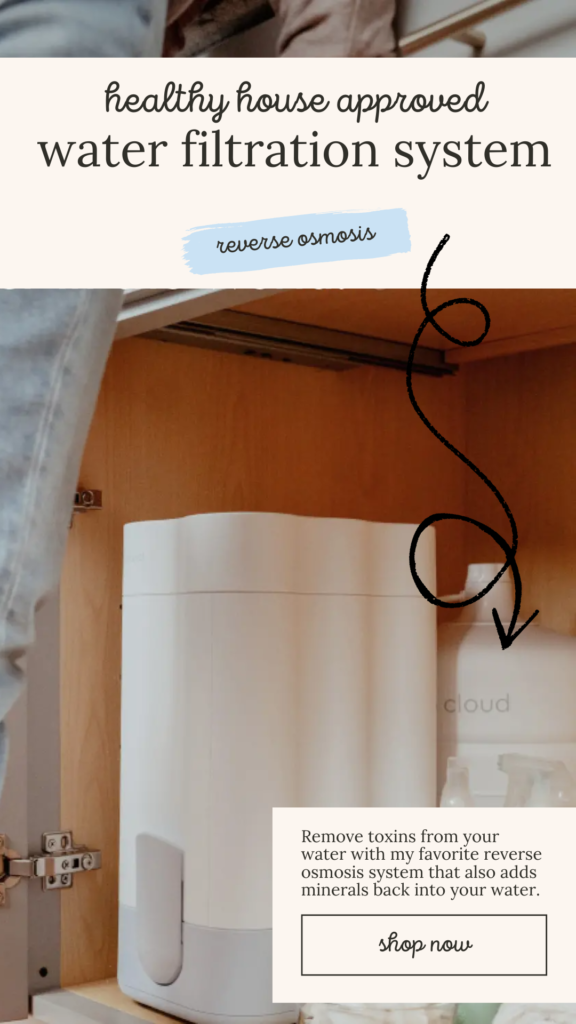
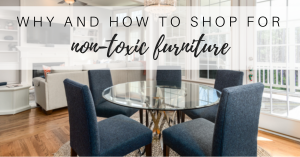
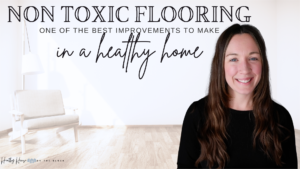

After my parent’s kitchen staying mostly unchanged for 30+ years they have started switching things up. I’m sure this worksheet will be of benefit to them so I’ll be sharing it with Mom.
Oh, that’s great!! I hope she finds it helpful!!
This is such a helpful info! Saving for later when I am going to make some renovations on my kitchen! thanks!
You’re so welcome!! I’m glad you can use it!!
I like the clean cut style
I am so bad at paying attention to NON TOXIC things. I just use the stuff at Target, the grocery store, etc for cleaning! I really need to pay more attention and take some of your ideas !!
Never too late to make a change!! This one was more about the actual materials in your kitchen though 😉
This is perfect timing for me! We’re about to rip out the counters and cabinets in my kitchen. It’s an old, old farmhouse and the ants keep getting in behind the cabinets. Plus, the counters are nasty stuff from the 70’s and who knows what under all that paint the last owners put down to cover gross stuff. I’m thinking of going for stainless steel because of how much we cook and clean in the kitchen.
Thank you for the checklist!
Stainless steel is such a great option! What a different look compared to ’70s countertops!!
We had a dishwasher turn itself on in the middle of the night and flood our kitchen! Needless to say, we had to do a full remodel. These are great tips! Since we needed all new everything, I was very conscious of choosing things that wouldn’t off-gas. We went with quartz for countertops and love them, but I had never heard of ice stone. It sounds amazing! Our favorite upgrade that we did was the backsplash–gray glass moroccan tiles. 🙂
Oh, that sounds just beautiful! Remodeling is a great time to be more careful with material choices….you’re so right!!
I would love to redo my kitchen, too. As you said, it’s very functional but I would want to change the look. It’s not in the budget now, but I’m saving this since our goal is to eventually be able to build our own home.
Oh, a new build would such an incredible experience! I’m actually consulting on a non toxic new build right now and it’s been such a fun project!
These are some great tips. Me and my mum were just planning to redecorate our kitchen. These tips will definitely come in handy.
Oh, that’s so great! I’m glad it’s helpful!!
Your posts are always so thorough and informative! Thank you so much! Now I wish I was remodeling my home.. but I’m always thinking, “Remember this when…”
Right!! Me too! I figure it’s just more time I can spend planning it out before the actual project. 😊 thanks for your kind words, Emily!
we are in the middle of our kitchen renovations so this looks like the perfect post for me! I love all of your suggestions!
So exciting! Remodels are such a fun thing for a house!!
This is very helpful! I am actually thinking of remodelling my kitchen and this is just a perfect timing. I would love to check this further and see what my options are. Thanks!
You’re so welcome!! I’m glad it’s a helpful resource!
I need your tips, I am going to remodel my kitchen soon. love the bright white theme
That’s exciting! Glad it was helpful.
I didn’t know that granite adds radon to the air! Thank you so much for sharing these tips. I found this post quite informative and will keep these points in mind while redecorating my kitchen ☺
I’m so glad! Yes, most don’t realize that it does add a bit of radon to the air…..so you’re not alone 😊
Takin care of the kitchen is something we really tend to think more. This is really nice guide.
Thank you!
My kitchen needs updated badly. These are all great options for us to consider as we start the planning process.
It’s nice to be able to take your time in planning out a remodel 😊
Two things I love are trying to reduce toxins and worksheets. I’m such a planner and really am trying to limit chemicals that me and my kids are exposed to. This is such a helpful post!
I’m so glad, Christa! We are like two peas in a pod 🙂
What do you think of Solid surface like Swanstone they make bath surrounds ( wall panels ) and vanitys and kitchen counters.
Hi Tamra – great question! Swanstone is made of polymers and alumina trihydrate. While polymer is a form of plastic, which I’m not a huge fan of, there really isn’t a whole lot of off-gassing from this type of product. You will want to pay attention to what type of adhesive/epoxy is used during installation, though.